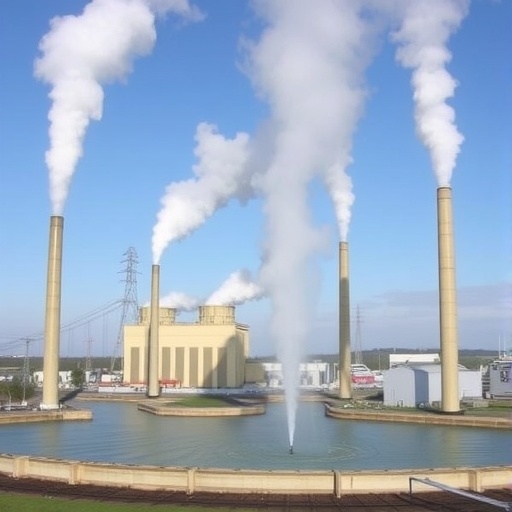A groundbreaking study led by Princeton engineers has revealed that wastewater treatment plants emit significantly higher quantities of potent greenhouse gases than previously estimated. Utilizing an innovative approach involving a state-of-the-art mobile laboratory, the research uncovers that emissions of methane and nitrous oxide from these facilities are nearly double what the Environmental Protection Agency (EPA) had accounted for. This paradigm-shifting discovery underscores the critical, yet overlooked, role wastewater plants play in the broader context of urban environmental impact and climate change mitigation.
The study, published in the esteemed journal Nature Water, details how the research team meticulously measured emissions from a diverse spectrum of wastewater treatment plants spread across the United States. Spearheaded by professors Mark Zondlo and Z. Jason Ren from Princeton University in collaboration with UC-Riverside’s Francesca Hopkins, the inquiry spanned 14 months and involved direct atmospheric monitoring of 96 plants. Collectively, these plants represent about 9 percent of the total wastewater treatment capacity in the country, offering a robust dataset that challenges prior national emission inventories.
Central to the success of their methodology was the use of the Princeton Atmospheric Chemistry Experiment, a custom-designed electric vehicle outfitted with advanced laser-based sensor systems. These technologies enabled real-time, sensitive detection of greenhouse gases such as methane and nitrous oxide as the mobile lab traversed roads encircling the plants. Unlike static measurements or extrapolations from limited samples, this dynamic approach captured a more comprehensive and nuanced picture of gas emissions, accounting for variables such as seasonality, weather, and operational conditions.
Results demonstrated that wastewater treatment facilities emit roughly 1.9 times the amount of nitrous oxide and 2.4 times the methane than previously recognized by EPA estimates. Given that methane and nitrous oxide are respectively 28 and over 250 times more potent than carbon dioxide in terms of global warming potential, these findings highlight a substantial additional source of climate forcing. The cumulative contribution of wastewater plants equates to approximately 2.5 percent of U.S. methane emissions and 8.1 percent of nitrous oxide emissions, a notable fraction considering the otherwise underexamined nature of these sources.
The variability inherent to biological wastewater treatment processes further complicates emissions assessment. Microbial populations responsible for degrading organic waste inevitably produce methane and nitrous oxide as metabolic byproducts, but reaction rates fluctuate widely. Factors such as wastewater composition, ambient temperature, precipitation events, and treatment technique diversity all influence emission profiles. The project’s comprehensive sampling regime, which entailed multiple visits per plant across differing environmental conditions, illuminated these dynamics with unprecedented clarity.
One surprising discovery was the transient and heterogeneous nature of emissions at certain sites. For instance, elevated nitrous oxide concentrations were sometimes detected near aeration tanks one week, only to drop to undetectable levels on subsequent visits. Such findings emphasize the complexity of microbial ecosystems within treatment plants and how operational or environmental changes can drastically alter emissions over short time frames. This temporal variability poses significant challenges to prior emission modeling efforts, which often relied on snapshot measurements from limited locations.
Historically, national greenhouse gas inventories relied on extrapolation from studies at a handful of treatment plants, typically focusing on ideal or laboratory conditions rather than real-world operational variability. The Princeton team’s large-scale, seasonally varied field data provides a more accurate foundation for recalibrating models and regulatory frameworks. The research highlights the necessity of monitoring full-facility emissions rather than isolated treatment stages or partial measurements, as plant infrastructure and processes have evolved considerably since many were originally constructed decades ago.
Despite the daunting scale of emissions, the study offers hope as a relatively small subset of facilities disproportionately contribute to total greenhouse gas outputs. Targeted interventions at these high-emission plants could achieve outsized reductions efficiently. The researchers advocate working closely with plant operators to characterize internal process emissions, operational inefficiencies, or aging equipment that may exacerbate gas release. Such insights would pave the way for tailored mitigation technologies that address both air quality and water treatment goals.
Moreover, the economic dimension of emissions management comes to the fore with the possibility of reclaiming methane as a renewable energy source. Wastewater facilities frequently generate methane, a compound traditionally viewed strictly as an environmental liability. Capture and utilization of this methane could yield not only greenhouse gas reductions but also provide a revenue stream or operational cost offset for utilities. This dual environmental and financial incentive underscores the integrative potential of emission control innovations.
The broader implications of this study reverberate through climate policy and urban infrastructure planning. The overlooked footprint of wastewater treatment architectures necessitates recalibrated national greenhouse gas accounting and incentivized emission reduction strategies. Enhancing transparency and empowering operators with better monitoring tools and guidance are essential next steps. As cities worldwide grapple with sustainability challenges, incorporating more accurate assessments of wastewater emissions can inform comprehensive climate action plans that bridge water and air quality considerations.
In summary, the pioneering work led by Princeton’s engineering team unveils a substantially underestimated source of climate-warming gases emanating from municipal wastewater plants. By deploying cutting-edge atmospheric measurement technology across hundreds of kilometers and seasons, the research presents a compelling case for overhauling traditional greenhouse gas inventories and targeting high-impact interventions at these facilities. These revelations are critical as urban centers aim to reconcile infrastructure demands with ambitious climate targets, emphasizing the importance of interdisciplinary collaboration and technological innovation in tackling complex environmental issues.
Subject of Research:
Not applicable
Article Title:
Comprehensive assessment of the contribution of wastewater treatment to urban greenhouse gas and ammonia emissions
News Publication Date:
8-Oct-2025
Web References:
http://dx.doi.org/10.1038/s44221-025-00490-z
Image Credits:
Nathan Li/Princeton University
Keywords:
Climatology, Climate change, Climate data, Atmosphere, Climate systems, Earth sciences, Atmospheric science, Atmospheric chemistry




